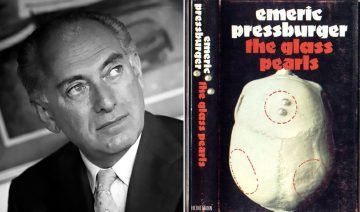Lucy Scholes at The Paris Review:
 In the aftermath of the dissolution of Pressburger and Powell’s partnership in the late fifties, Pressburger turned to novels. The first, Killing a Mouse on a Sunday, published in 1961, is set during the aftermath of the Spanish Civil War and tells the story of a once notorious bandit, now a tired old man living in exile in France who resolves to cross the border back into Spain, despite the danger to his life, to visit his dying mother. In an interview published in the Daily Mail at the time, Pressburger explained that after years of “communal” creativity in the world of film, he wanted to “prove I could do something on my own.” The novel met with favorable reviews, was quickly translated into a dozen languages, and adapted for the big screen in 1964 as Behold a Pale Horse, directed by Fred Zinnemann and starring Gregory Peck, Omar Sharif, and Anthony Quinn. (That the film itself died a quick death didn’t really matter.) Everything was set for Pressburger’s second novel to build on this success. Unfortunately, this wasn’t to be. The Glass Pearls, published in 1966, was a much darker, grittier tale about a Nazi war criminal hiding in plain sight in the dingy streets of London’s Pimlico. It garnered one lone review, a damning write-up in the Times Literary Supplement. The book barely sold its initial print run of four thousand copies, immediately sinking without a trace. And yet, despite the reception it received at the time, The Glass Pearls is a truly remarkable work. It deserves to be recognized both for its own virtuosity, and as an important addition to the genre of Holocaust literature.
In the aftermath of the dissolution of Pressburger and Powell’s partnership in the late fifties, Pressburger turned to novels. The first, Killing a Mouse on a Sunday, published in 1961, is set during the aftermath of the Spanish Civil War and tells the story of a once notorious bandit, now a tired old man living in exile in France who resolves to cross the border back into Spain, despite the danger to his life, to visit his dying mother. In an interview published in the Daily Mail at the time, Pressburger explained that after years of “communal” creativity in the world of film, he wanted to “prove I could do something on my own.” The novel met with favorable reviews, was quickly translated into a dozen languages, and adapted for the big screen in 1964 as Behold a Pale Horse, directed by Fred Zinnemann and starring Gregory Peck, Omar Sharif, and Anthony Quinn. (That the film itself died a quick death didn’t really matter.) Everything was set for Pressburger’s second novel to build on this success. Unfortunately, this wasn’t to be. The Glass Pearls, published in 1966, was a much darker, grittier tale about a Nazi war criminal hiding in plain sight in the dingy streets of London’s Pimlico. It garnered one lone review, a damning write-up in the Times Literary Supplement. The book barely sold its initial print run of four thousand copies, immediately sinking without a trace. And yet, despite the reception it received at the time, The Glass Pearls is a truly remarkable work. It deserves to be recognized both for its own virtuosity, and as an important addition to the genre of Holocaust literature.
more here.
